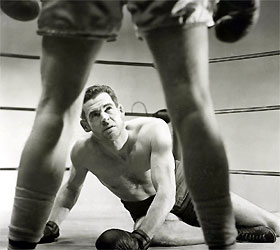The Set-Up (1949), The Captive City (1952), Thunder Road (1958)
Ah....I know that smell. It's those fetid odors, those lived in sweat pants that only the cozy box-like theater at Film Forum can offer us. And I'd have it no other way. So of course, it was my first day of B-Noir.
Today was Robert Wise day. I came in skeptical, because Wise was that scoundrel who edited down The Magnificent Ambersons into the malformed masterpiece it is today. Sure, someone else would've done it if he refused, but one must have principles.
Regardless, The Set-Up is a fabulous piece of work. Adapted from the narrative poem by Joseph
 Moncure March, it unspools in an approximation of real time, the action taking place during a single night in the seedy part of Paradise City. There are three sets, an apartment interior, a city street, and the boxing auditorium. This restriction allows a remarkable buildup of tension. Robert Ryan plays Stoker Thompson, a used up pug filling out the undercard at a second-rate dive. His wife Julie (Audrey Totter), wants him to retire and stop getting the shit kicked out of him. She refuses to go to the night's fight. This plot strand is built upon the rest of the film, as Stoker repeatedly stares out from his locker room at the aud to his apartment window, the space compressed to service his psychology. He hopes the light flicks off, marking her departure and supposed arrival. Other visual cues are less effective and rely too much on symbolism, like the toy boxer at the arcade getting knocked out, a man lighting a match on Stoker's name on the card, and the repeated close-ups of ghoulish fans screaming for blood. Wise ain't the subtle type.
Moncure March, it unspools in an approximation of real time, the action taking place during a single night in the seedy part of Paradise City. There are three sets, an apartment interior, a city street, and the boxing auditorium. This restriction allows a remarkable buildup of tension. Robert Ryan plays Stoker Thompson, a used up pug filling out the undercard at a second-rate dive. His wife Julie (Audrey Totter), wants him to retire and stop getting the shit kicked out of him. She refuses to go to the night's fight. This plot strand is built upon the rest of the film, as Stoker repeatedly stares out from his locker room at the aud to his apartment window, the space compressed to service his psychology. He hopes the light flicks off, marking her departure and supposed arrival. Other visual cues are less effective and rely too much on symbolism, like the toy boxer at the arcade getting knocked out, a man lighting a match on Stoker's name on the card, and the repeated close-ups of ghoulish fans screaming for blood. Wise ain't the subtle type.But these are minor quibbles. Robert Ryan is marvelous as usual, a bemused grin masking the anxiety of aging throughout. His wrinkles say it all. The footage of the boxing match is superb, and we get all four rounds in great detail. Sweat rainbows off their brows as the camera is set down by the apron, capturing each physical exertion, the same type of shot Astaire demanded of his directors to capture all of his dance moves.
He's asked to throw the fight before the last round begins. He thinks he can win. The pride of a wounded warrior versus making a few bucks and leaving this shithole of a town. He's Robert Ryan, so he lays out the punk. He wins in the ring. Then he loses in the alley. Then he wins again, bleeding in the street, cradled by Julie. Oh I wish her last wide-eyed melodramatic line was cut out, and we were left with two hopeful bodies spitting at fate and treasuring a moral victory over the transience of physical pain. Oh Wise, you almost had a masterpiece in you. But close is still pretty good.
The Captive City, on the other hand, was rote civic duty mush ladled with some sort of ladle. The mob is bad and families are good and there's no time for character or image because we're talking about how bad the mob is and how great self-righteousness is. Sigh.
 Thunder Road was also poor, but in a more satisfying way. A vanity project for Robert Mitchum, he wrote the story, produced, starred, and wrote the the theme song. If only he hired a competent director. Here he's left with Arthur Ripley (who hadn't directed a feature for 9 years, according to IMDB). Shots don't match during shot-countershot sequences, the pace lags horribly, and the supporting performers are woodenly ineffective, aside from Mitchum's son James, who looks exactly like his father (playing his brother) and tries to imitate his dad's elongated drawl. But you know, it's Mitchum, and he wears his pants high and his pompadour higher, and he sweats quite a bit. That's enough for my $5 investment.
Thunder Road was also poor, but in a more satisfying way. A vanity project for Robert Mitchum, he wrote the story, produced, starred, and wrote the the theme song. If only he hired a competent director. Here he's left with Arthur Ripley (who hadn't directed a feature for 9 years, according to IMDB). Shots don't match during shot-countershot sequences, the pace lags horribly, and the supporting performers are woodenly ineffective, aside from Mitchum's son James, who looks exactly like his father (playing his brother) and tries to imitate his dad's elongated drawl. But you know, it's Mitchum, and he wears his pants high and his pompadour higher, and he sweats quite a bit. That's enough for my $5 investment.

0 Comments:
Post a Comment
<< Home